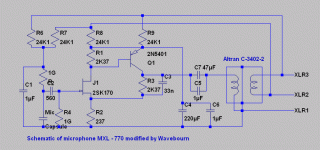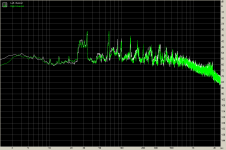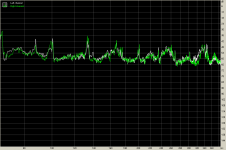Right. And you are talking about bass quality, not just bass quantity.Now with bass traps in all 4 corners top to bottom and 4 active subs I am finally satisfied.
The room is just as much a part of the equation as is you low frequency target.
You mention "active subs". Odd that this thread hasn't talked about motional feedback which is the direct road to quality bass. There are a few commercial systems available. Have you tried it?
BTW, a motional feedback sub will also act as an active room resonance trap since it is topologically the same.
B.
Last edited:
Thanks for rerunning that Bill.OK here is a bigger window size.
 What the heck is that giant peak circa 28 Hz? Is it in the music? It looks like the kind of peak I see from tonearm/cart resonance, but higher in frequency.
What the heck is that giant peak circa 28 Hz? Is it in the music? It looks like the kind of peak I see from tonearm/cart resonance, but higher in frequency.Curious as to what it is.
Thinking about this, wouldn't it act as trap only at the point in space that it occupies? Therefore a corner position would make most sense?BTW, a motional feedback sub will also act as an active room resonance trap since it is topologically the same.
I will have to have another listen and try and pull out what it is. Fucik liked a fairly large percussion section.
The recording was at the Royal Concert Hall, Glasgow which was only reopened in 2015 and has all the modern bells and whistles of adjustable damping. I'll sample a quiet, percussion free section of the music as well.
EDIT:correction that was the old hall the new hall only opened after this CD was released. I'll grab a recording from the new space
The recording was at the Royal Concert Hall, Glasgow which was only reopened in 2015 and has all the modern bells and whistles of adjustable damping. I'll sample a quiet, percussion free section of the music as well.
EDIT:correction that was the old hall the new hall only opened after this CD was released. I'll grab a recording from the new space
Last edited:
Agreed. I my experience Reggae music was early into this. The PA is one of the musical instruments. 🙂 Much of what I hear people trying to reproduce at home is not the sound of instruments, it's sounds played back live thru many large speaker cones with kilowatts of power. That's what most people hear and concerts, and it's their reference.Going to a live act of Bassnectar, Kraftwerk or other music produced by non acoustic instruments where the artist make the choice of the system IS the equivalent of going to a concerthall to listen to a real orchestra and have a reference for the sound of real instruments.
I'd love to see that link. Most guys I know who mix Front of House just do this EQ shape from experience, seeing some studies and graphs would be nice.I can give a link with example from DB or EV with this kind of curve. I takes into account the 4pi radiation in open space/ outdoor and the need for headroom in the 50hz area where most of fundemental energy is.
Good sounding PA follow almost always this target from my experience.
For me it's not about how low can you go, but can you do reasonable low end with massive clean SPL? A solid response into the mid 30s seems to cover that well. Extreme SPL bass, not extreme low frequency bass.In the end i agree with you Pano. As a Drum & Bass Dj (using exclusively vinyl medium) i don't feel the need to go lower than 30hz except for maybe 5 or 6 tracks in my whole D&B collection (300+).
But who knows? As the subs get bigger and play lower, musicians and DJs will probably start digging deeper, because they can.
Good thinking. That would help us know if it's the room, or air handling, or the music.. I'll sample a quiet, percussion free section of the music as well.

But who knows? As the subs get bigger and play lower, musicians and DJs will probably start digging deeper, because they can.
This reminds me of Tom's uncompressed 'car door slam' recording with its super low ~2 Hz [IIRC] sub harmonic!
GM
For me it's not about how low can you go, but can you do reasonable low end with massive clean SPL? A solid response into the mid 30s seems to cover that well. Extreme SPL bass, not extreme low frequency bass.
Pano, do you think that sometimes would be a good idea to have higher efficiency cabs to reach higher SPL and use bass synthesizer to trade low end to a little higher frequency?
...
For me it's not about how low can you go, but can you do reasonable low end with massive clean SPL? A solid response into the mid 30s seems to cover that well. Extreme SPL bass, not extreme low frequency bass.
But who knows? As the subs get bigger and play lower, musicians and DJs will probably start digging deeper, because they can.
It depends on the artist. UK dubstep and DnB aren't necessarily good examples. There's more of that material North America actually hence the push for heavy systems from PK in Calgary and Meyer Sound Berkeley. They're leaders in this field and it's where things are trending now
Regarding house panels, were were watching the mix engineer a big Bassnectar show. There was a huge EQ peak at around 50hz, not sure how much, but that's both a good and bad thing.
When there's so much gain like that, it can ring over the articulation of a kick attack and make modified 808 samples sound like a big drone. This has to be balanced to some degree and not dramatically alter the intent of the track.
Don't Hate The 808 was that track by him btw
In theory, yes. I've built circuits that had notable 3rd harmonic distortion in the bass, but they were met with glowing praise. Amazing, strong bass! How do you do it? 🙂Pano, do you think that sometimes would be a good idea to have higher efficiency cabs to reach higher SPL and use bass synthesizer to trade low end to a little higher frequency?
But in practice in a home system? I don't know. Certainly clean bass often doesn't sound as loud as distorted bass. And many cheap little boomboxes and HT system use bass synthesizers to boost the bass. On a larger, better system I'm not sure it would be desirable.
For me it's not about how low can you go, but can you do reasonable low end with massive clean SPL? A solid response into the mid 30s seems to cover that well. Extreme SPL bass, not extreme low frequency bass.
For me too. Completely agree.....
I've been building my dual 18 BR boxes with around a 31Hz f3...
Don't need to go any lower, just need a bunch more boxes 😉
Oh, and @ billshurv.......another thanks for the rerun
ok here is a recording done in the new purpose built hall in Glasgow. If anything it's even odder. The linear plot shows peaks down to 3Hz but you can't expand the scales to look closely. If anyone has better analysis sw I'll send them a chunk to look at.
This level of subsonics is daft though. I suspect audacity but might right to Chandos and just ask them the question!
This level of subsonics is daft though. I suspect audacity but might right to Chandos and just ask them the question!
Attachments
I THINK that is because square waves may have senoidal components in the 3Hz spectra, depending on what type of mathematical transform is used in the analyses. Well it might suit a subsonic speaker workable basis but just for casual ringes down to a component part not a really sounding note...
Thinking about this, wouldn't it act as trap only at the point in space that it occupies? Therefore a corner position would make most sense?
I suppose all traps only work at the point in space that they occupy except perhaps those using quantum mechanics.
The benefit of using corners for subs and absorption has been re-examined in recent years, not to mention many questions about proper absorption location in rooms and studios. Perhaps wiser heads can answer your question.
B.
The trap works outside its position. The openings provide a cone of pressure gradient where impedance match is provided between the ressonant pressurized air and outside air. In principle this can outperform shorter than necessary horns.
For example a common port will release a pressure cone the shape of a bullet protuding to the outrr side of the enclosure. The pressure inside the enclosure is always a bit higher than atm pressures. The difference itself and the cone volume are compared to SPL levels of the system but the point is how efficiently sound can go outside without reflecting again in a fashion that does not perfectly fits the working principle of a tuned port.
Some recently released corner subwoofer technology relies in this principle so does fan based infrasonic subs.
Bern
For example a common port will release a pressure cone the shape of a bullet protuding to the outrr side of the enclosure. The pressure inside the enclosure is always a bit higher than atm pressures. The difference itself and the cone volume are compared to SPL levels of the system but the point is how efficiently sound can go outside without reflecting again in a fashion that does not perfectly fits the working principle of a tuned port.
Some recently released corner subwoofer technology relies in this principle so does fan based infrasonic subs.
Bern
Last edited:
Odd indeed! I have some other ways to analyze and would be happy to do so. Send me a PM and we'll see what we can find.ok here is a recording done in the new purpose built hall in Glasgow. If anything it's even odder.
Pano, do you think that sometimes would be a good idea to have higher efficiency cabs to reach higher SPL and use bass synthesizer to trade low end to a little higher frequency?
Been there, done that as well as 'doubling down' back when the dbx120 came out and while entertaining, definitely not HIFI, but then I started with an in room 106+ dB/4 ft efficiency which highlights ANY type noise/distortion, so maybe fine at a more typical 'high' efficiency or maybe electronics have advanced enough since the late '70s, early '80s to have a sufficiently low noise floor.
GM
What microphone was this recorded on? Helicopters produce very low (single digit) Hz IIRC, so the fact there are the big peaks but then not much below 35Hz makes me wonder if the mic was rolling off.
I don't think so. There were my microphones, directly connected to Tascam DR-100
It is obvious that the helicopter produced almost 35 and 70 Hz, the rest was way below their level.
0.3 Hz corner frequency for input RC, 80 Henry primary of the transformer, 22 mm capsules from MXL-770 microphones.
Attachments
Well; the capsule itself has about 100 pF capacitance, loaded on 0.5G - is it about 3 Hz -3 dB frequency?
Yep, looks like 35 and 70 Hz was what the helicopter produced.
What is clearly shown with a longer FFT is the Blade Pass Frequency (BPF) single component and it’s exact harmonics up to the 11nth:
33.5Hz, 67Hz, 100.5Hz, 134Hz, 167.5Hz, 201Hz, 234.5hz, 268Hz, 301.5Hz, 334Hz, 368.5Hz .
The waviness is again of a period corresponding to the BPF.
BPF=main rotor’s RPM * No of blades / 60
For 2 blade main hub, rotor rpm=1050
For 3 blade main hub, rotor rpm=700
For 4 blade main hub, rotor rpm=525
The BPF is the lowest frequency main aerodynamic component.
http://www.dtic.mil/dtic/tr/fulltext/u2/684394.pdf
https://ntrs.nasa.gov/archive/nasa/casi.ntrs.nasa.gov/19880017523.pdf
George
Attachments
- Status
- Not open for further replies.
- Home
- Loudspeakers
- Subwoofers
- Realistically, how low is bass in music?



